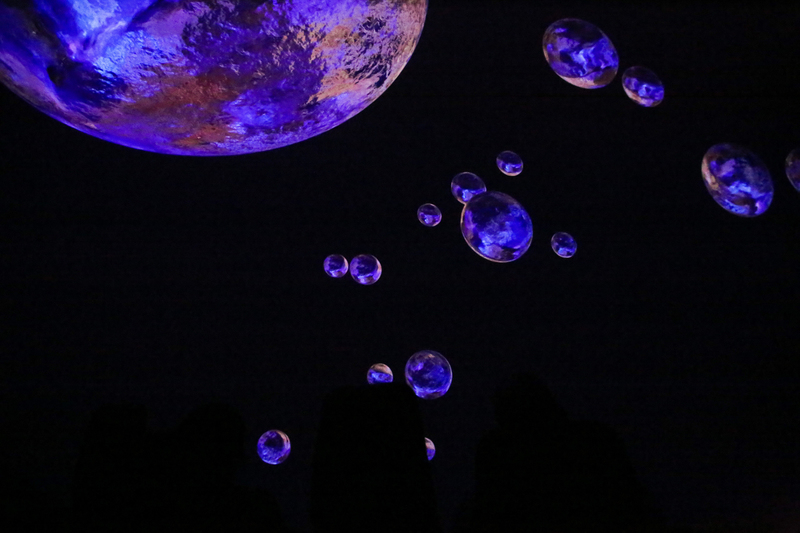Experimental film at Iziko Planetarium and Digital Dome
18 November 2019 | Story Sarah Middleton. Photos Je’nine May. Read time 5 min.
The Centre for Curating the Archive (CCA) at the University of Cape Town’s (UCT) Michaelis School of Fine Art recently hosted an experimental film festival, Under the Dome, at the Iziko Planetarium. The festival, which ran from Friday, 15 November, to Sunday, 17 November, showcased nine films created for the Iziko Planetarium and Digital Dome.
The Iziko Planetarium and Digital Dome is the most advanced digital planetarium in Africa. First constructed in the 1950s with a dome that was built in the 1980s, the original planetarium used a “star machine” to simulate the night sky by projecting images onto the planetarium dome. But the technology of the planetarium became increasingly outdated as full-dome digital technology became the norm around the world.
In response to this, the planetarium undertook a refurbishment project and, in 2017, re-opened its doors to showcase its new, highly advanced digital dome. The technological development has been enormously significant for the planetarium, but there has been a lack of locally produced content available to display on the dome.
Until now.
“There are ways in which proprietorial control has been maintained over these digital systems so that a lot of the material comes from the United States and Europe – and it’s been incredibly difficult to even imagine creating content for the digital dome locally,” said Professor Pippa Skotnes, director of the CCA.
When the Mellon Foundation supported the collaboration between Iziko Museums, the Michaelis School of Fine Art and the CCA, the possibility of creating local content for the digital dome was realised. The collaboration resulted in the formation of a team of researchers who worked with relevant software to create material “that could be projected in this incredibly, wonderfully immersive environment”.
Artistic works for the digital dome
“I know this has been a long ambition from Iziko’s side and as artists … the potential for the dome to produce artistic works is something that’s really incredibly exciting, and I think we can all picture what could happen here,” Skotnes said.
Martin Wilson, a lecturer at the Michaelis School of Fine Art and a researcher at the CCA, said: “The film Fragments of an Untold History was proposed by Pippa [Skotnes] and Theo [Ferreira] because they wanted to see if we could make a local production.
Attendees at Under the Dome – an experimental film festival that took place at the Iziko Planetarium.
“What we realised during the production of that film is that there are so many ways you can use the dome, and we only have one team . . . We needed more brains working on the matter,” said Wilson.
“We needed some people who wanted to use 2D video, some people who generated [computer-generated imagery], some people who would film in 360 degrees, and all the different directions simultaneously, and work out what might work, what won’t work, what’s expensive and what isn’t.”
The result of this collaborative project is a diverse collection of short films. Some are documentary in nature, such as Fragments of an Untold History, which describes the discovery of thousands of buttons near the Platteklip stream where slaves once washed clothes.
By contrast, abstract films such as Kali van der Merwe and Simon Dunckley’s Animortis, is only somewhat narrative in nature, focusing instead on animal and insect corpses which are reanimated using stop motion against a background of stars and celestial smoke.
Lyndall Cain, liaison officer and course convener at the CCA, and project manager of the film festival, said that it was not difficult to find filmmakers who were keen to tackle a project for the digital dome.
“What we could offer them was space in the dome and some technical assistance from Martin [Wilson]. They had to have time to put towards the project and they had to be willing to do it on a budget.”
Award winners
Louise Coetzer and Oscar O’Ryan’s experimental film WRDP won the award for best film on the opening night. WRPD utilises dance to “trace distortions of the physical form, placed against a surreal landscape”.
The prize, sponsored by the Sutherland Planetarium, includes two days’ use of the Sutherland Planetarium / Digital Dome where the winners can choose to work on new material or showcase their existing work.
The Iziko Planetarium and Digital Dome will be screening several of the films as shorts before their normal programming.
 This work is licensed under a Creative Commons Attribution-NoDerivatives 4.0 International License.
This work is licensed under a Creative Commons Attribution-NoDerivatives 4.0 International License.
Please view the republishing articles page for more information.
Related




















